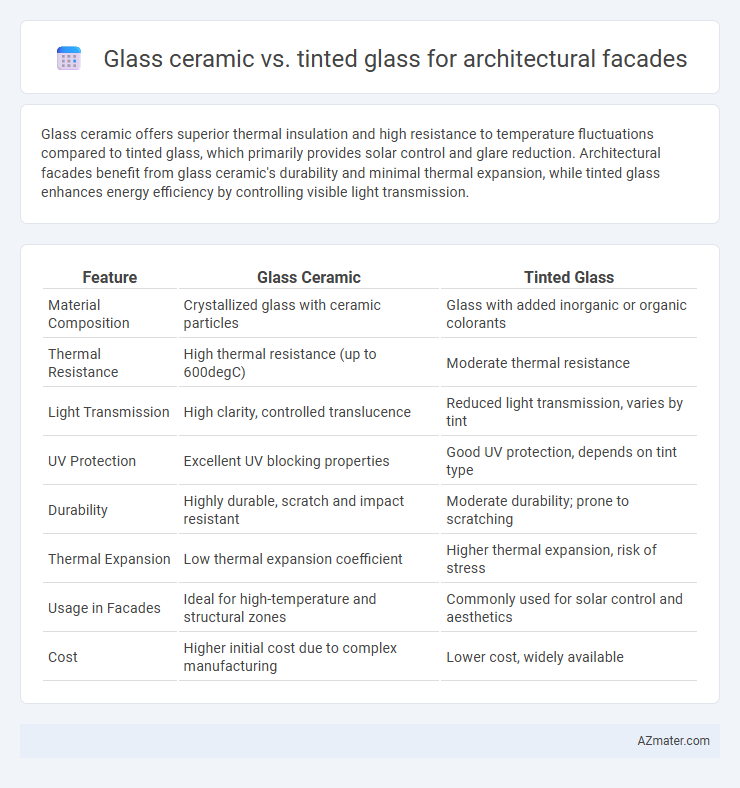Glass ceramic offers superior thermal insulation and high resistance to temperature fluctuations compared to tinted glass, which primarily provides solar control and glare reduction. Architectural facades benefit from glass ceramic's durability and minimal thermal expansion, while tinted glass enhances energy efficiency by controlling visible light transmission.
Table of Comparison
| Feature | Glass Ceramic | Tinted Glass |
|---|---|---|
| Material Composition | Crystallized glass with ceramic particles | Glass with added inorganic or organic colorants |
| Thermal Resistance | High thermal resistance (up to 600degC) | Moderate thermal resistance |
| Light Transmission | High clarity, controlled translucence | Reduced light transmission, varies by tint |
| UV Protection | Excellent UV blocking properties | Good UV protection, depends on tint type |
| Durability | Highly durable, scratch and impact resistant | Moderate durability; prone to scratching |
| Thermal Expansion | Low thermal expansion coefficient | Higher thermal expansion, risk of stress |
| Usage in Facades | Ideal for high-temperature and structural zones | Commonly used for solar control and aesthetics |
| Cost | Higher initial cost due to complex manufacturing | Lower cost, widely available |
Introduction to Façade Material Choices
Glass ceramic offers superior thermal insulation and durability for architectural facades, making it ideal for energy-efficient building designs. Tinted glass provides enhanced solar control by reducing glare and heat gain, contributing to occupant comfort and energy savings. Selecting between glass ceramic and tinted glass depends on performance priorities such as insulation, light transmission, and aesthetic appeal for facade applications.
Overview of Glass Ceramic in Architecture
Glass ceramic in architectural facades offers exceptional thermal stability and resistance to weathering compared to tinted glass, enabling enhanced energy efficiency and durability. Its microcrystalline structure provides superior mechanical strength and resistance to thermal shock, making it ideal for high-performance building envelopes. Unlike tinted glass, glass ceramic maintains optical clarity while allowing for customized light diffusion and heat control, optimizing natural illumination without compromising structural integrity.
Understanding Tinted Glass for Building Facades
Tinted glass for building facades enhances energy efficiency by reducing solar heat gain and glare while improving occupant comfort. Unlike glass ceramic, tinted glass allows for a variety of color options and light transmittance levels, making it adaptable to architectural design and climate requirements. Its ability to filter specific wavelengths helps in controlling indoor temperature, thereby lowering HVAC energy costs.
Aesthetic Differences: Visual Impact & Design Flexibility
Glass ceramic offers a sleek, uniform appearance with excellent control over opacity and light diffusion, enhancing modern minimalist facades. Tinted glass provides varied color options that dynamically change with sunlight, adding depth and warmth to architectural designs. Design flexibility favors glass ceramic for precise translucency effects, while tinted glass excels in customizable shading and energy efficiency for facades.
Light Transmission and Daylighting Performance
Glass ceramic offers controlled light transmission with high thermal stability, providing consistent daylighting performance ideal for architectural facades that require glare reduction and UV protection. Tinted glass modulates solar heat gain by absorbing and filtering sunlight, which can lower light transmission but enhance energy efficiency by reducing cooling loads. Selection between glass ceramic and tinted glass depends on balancing desired daylight levels with energy savings and visual comfort in facade design.
Thermal Insulation and Energy Efficiency
Glass ceramic offers superior thermal insulation for architectural facades due to its low thermal conductivity and resistance to temperature fluctuations, significantly reducing heat transfer and improving energy efficiency. Tinted glass helps control solar heat gain by absorbing and reflecting sunlight, thereby lowering cooling loads but often provides less insulation compared to glass ceramics. Combining glass ceramic with tinted coatings can optimize facade performance by enhancing both thermal insulation and solar energy management in buildings.
Durability and Maintenance Requirements
Glass ceramic offers superior durability for architectural facades due to its resistance to thermal shock, scratches, and chemical exposure, reducing the need for frequent repairs or replacements. Tinted glass, while providing effective solar heat gain control and glare reduction, is more susceptible to fading, scratches, and coatings that may degrade over time, increasing maintenance demands. The long-term cost-effectiveness of glass ceramic often surpasses tinted glass because of its robust performance and minimal upkeep requirements in harsh environmental conditions.
Environmental Impact and Sustainability
Glass ceramic facades offer superior thermal insulation and durability, reducing energy consumption and extending building lifespan compared to standard tinted glass. Tinted glass lowers solar heat gain, decreasing cooling loads but may contain metal oxides that complicate recycling processes. Choosing glass ceramic emphasizes sustainability through lower embodied energy and enhanced recyclability, supporting green building certifications and long-term environmental benefits.
Cost Comparison and Long-term Value
Glass ceramic offers higher upfront costs due to advanced manufacturing processes but provides superior thermal insulation and durability, reducing long-term energy expenses and maintenance needs. Tinted glass has a lower initial price and effectively reduces solar heat gain, yet it may require more frequent replacement and maintenance, increasing lifetime costs. Evaluating total cost of ownership highlights glass ceramic as a cost-effective option for sustainable architectural facades with long-term value.
Best Applications: When to Choose Glass Ceramic vs Tinted Glass
Glass ceramic is best suited for architectural facades requiring high thermal resistance, durability under extreme weather, and resistance to thermal shock, making it ideal for buildings in harsh climates or with large South-facing facades exposed to intense sunlight. Tinted glass is preferred for reducing glare, controlling solar heat gain, and enhancing privacy in commercial or residential buildings where energy efficiency and occupant comfort are priorities. Choosing glass ceramic over tinted glass depends on the need for superior thermal stability and strength, while tinted glass excels in aesthetic customization and moderate solar control.

Infographic: Glass ceramic vs Tinted glass for Architectural facade
 azmater.com
azmater.com